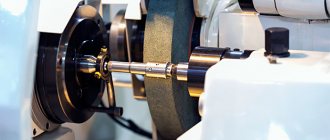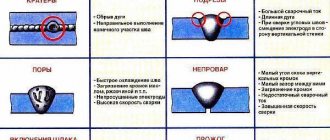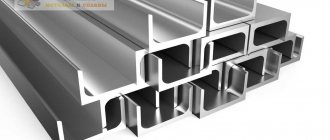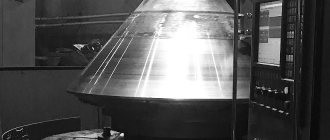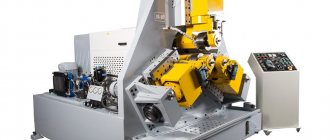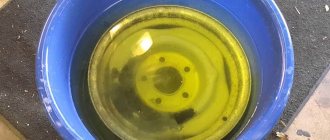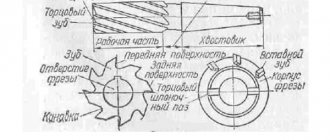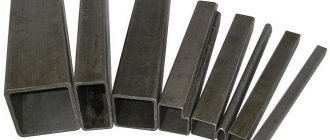Poor connections can cause accidents. Pipelines, parts subject to dynamic loads, and welds exposed to fracture must not contain slag, cavities, or lack of fusion. Methods for flaw detection of welds belong to non-destructive diagnostics. They are used to identify internal, invisible defects in the metal - discontinuities that reduce the strength of the connection.
10 diagnostic methods have been developed, all of them have advantages, disadvantages and limitations. Flaw detection of welded seams checks the quality of welders’ work and identifies technology violations. They use metal diagnostic methods for incoming, intermediate and acceptance inspection.
Types of inspection of welded joints
There are visible weld defects and invisible (hidden) ones. The first ones can be easily seen with the eyes, some of them are not very large, but using a magnifying glass it is not a problem to detect them. The second group is more extensive, and such defects are located inside the body of the weld.
There are two ways to detect hidden defects. The first method is non-destructive. The second is destructive. The first option, for obvious reasons, is used most often.
Non-destructive method of quality control of welds There are several methods in this category that are used to check the quality of welds.
- Visual inspection (external).
- Magnetic control.
- Radiation flaw detection.
- Ultrasonic.
- Capillary.
- Permeability testing of welded joints.
There are other methods, but they are not used often.
Results Evaluation Options
Interpretation of the results obtained by ultrasonic testing methods when sounding welded joints is one of the important stages of the work.
When a defect is detected, measure:
- The depth of the defect.
- Length.
- Distance between defects (if there are several of them).
- Maximum amplitude from the signal.
- Total length of defects.
The results are recorded in the control log, as well as in the conclusion or protocol. The control log indicates:
- The number of the welding joint according to the form and its type;
- length of the controlled area;
- SOP No.;
- operating frequency and input angle;
- control results;
- areas that could not be controlled (in the absence of access);
- date of inspection and signature of flaw detectors.
Defects detected during inspection are described using alphanumeric designations. To indicate defects, GOST 14782 should be used.
Visual inspection
Using an external examination, you can identify not only visible seam defects, but also invisible ones. For example, the unevenness of the seam in height and width indicates that there were interruptions in the arc during the welding process. And this is a guarantee that the seam inside has lack of penetration.
How to properly conduct an inspection.
- The seam is cleaned of scale, slag and drops of metal.
- Then it is treated with technical alcohol.
- After another treatment with a ten percent solution of nitric acid. It's called etching.
- The surface of the seam is clean and matte. The smallest cracks and pores are clearly visible on it.
Attention! Nitric acid is a material that corrodes metal. Therefore, after inspection, the metal weld must be treated with alcohol.
The magnifying glass has already been mentioned. Using this tool you can detect tiny flaws in the form of thin cracks less than a hair thick, burns, small cuts and others. In addition, using a magnifying glass you can check whether the crack is growing or not.
During inspection, you can also use calipers, templates, and a ruler. They measure the height and width of the seam, its even longitudinal location.
Magnetic inspection of welds
Magnetic flaw detection methods are based on the creation of a magnetic field that penetrates the body of the weld. For this purpose, a special apparatus is used, the operating principle of which is based on the phenomena of electromagnetism.
There are two ways to determine a defect within a connection.
- Using ferromagnetic powder, usually iron. It can be used both dry and wet. In the second case, iron powder is mixed with oil or kerosene. It is sprinkled on the seam, and a magnet is installed on the other side. In places where there are defects, powder will collect.
- Using ferromagnetic tape. It is laid on the seam, and the device is installed on the other side. All defects that appear at the junction of two metal workpieces will be displayed on this film.
This option for flaw detection of welded joints can be used to control only ferromagnetic joints. Non-ferrous metals, steels with chrome-nickel coating and others are not controlled in this way.
Advantages and disadvantages
Advantages:
- low labor intensity of research, connections are controlled by one person within a few minutes;
- safety of monitoring, only radiation diagnostics assumes the influence of harmful factors;
- a variety of monitoring devices; mobile flaw detectors are produced for basic flaw detection methods;
- variety of controlled objects: flat, three-dimensional parts, pipes are checked;
- control of seams produced by any type of welding machine.
Flaws:
- each method has certain limitations on its use due to the identified shortcomings;
- the need to use special reagents and consumables;
- it is necessary to specially prepare the surfaces being examined;
- After diagnostics, controlled fragments must be additionally treated with anti-corrosion agents; when removing scale and oxide film, the protective properties of the metal deteriorate.
Ultrasonic flaw detection
This is another accurate option for detecting flaws in a weld. It is based on the property of ultrasonic waves to be reflected from the surface of materials or media with different densities. If the weld has no defects within itself, that is, its density is uniform, then sound waves will pass through it without interference. If there are defects inside, and these are cavities filled with gas, then inside you get two different environments: metal and gas.
Therefore, ultrasound will be reflected from the metal plane of the pore or crack, and will return back, displayed on the sensor. It should be noted that different flaws reflect waves differently. Therefore, the results of flaw detection can be classified.
This is the most convenient and fastest way to control welded joints of pipelines, vessels and other structures. Its only drawback is the difficulty of decoding the received signals, so only highly qualified specialists work with such devices.
Critical angles
When performing ultrasonic testing, the operator needs to select the type of transducer, calibrate and configure the device for the expected defects of the object. Critical angles of incidence (longitudinal and transverse) must be taken into account when ultrasound passes through solid surfaces of materials.
The first critical angle is the smallest angle of incidence of the longitudinal wave at which the refracted ray does not cross the boundary of the second solid medium. For example, for the plexiglass-steel boundary it is 27.5º.
We recommend reading Rules for welding work
The second critical angle is considered to be the smallest angle of incidence of the longitudinal beam at which refraction does not penetrate through the boundary into the second solid medium and internal damage is not detected. For plexiglass-steel it is 57.5º.
The third critical angle is the smallest angle of incidence of the transverse beam at which there is no reflected longitudinal wave. The beam travels along the surface of the object without recognizing defects inside it. To cross the steel-air boundary, the angle is 33.3º.
Penetrant control
Methods for monitoring welds using the capillary method are based on the properties of certain liquids to penetrate into the body of materials through the smallest cracks and pores, structural channels (capillaries). The most important thing is that this method can control any materials of different densities, sizes and shapes. It doesn’t matter if it’s metal (black or non-ferrous), plastic, glass, ceramics and so on.
Penetrating liquids seep into any imperfections in the surface, and some of them, for example, kerosene, can pass right through fairly thick products. And most importantly, the smaller the size of the defect and the higher the absorption of the liquid, the faster the process of detecting the defect occurs, the deeper the liquid penetrates.
Today, specialists use several types of penetrating liquids.
Selecting a method
The main parameters of the seams under study are taken into account:
- physical characteristics;
- thickness and dimensions of workpieces;
- surface condition: for ultrasound, cleaning with contact lubricant is required, for the magnetic resonance method, the seam is upset (surface stress is removed), for capillary examination, a perfectly flat and cleaned surface is required.
When choosing a flaw detection method, you must consider:
- the sizes of permissible defects, the sensitivity of the devices is selected according to the technical conditions;
- research conditions.
If it is important to identify volumetric defects and voids, it is more reliable to carry out radiation monitoring. Cracks and lack of penetration are determined by ultrasound and a magnetic field. Defects that appear on the surface are detected using the capillary method.
Penetrants
From English this word is translated as absorbent. Currently, there are more than a dozen penetrant compositions (aqueous or based on organic liquids: kerosene, oils, and so on). They all have low surface tension and strong color contrast, making them easy to see. That is, the essence of the method is this: a penetrant is applied to the surface of the weld, it penetrates inside, if there is a defect, it is painted on the same side after cleaning the applied layer.
Today, manufacturers offer different penetrating liquids with different flaw detection effects.
- Luminescent. From the name it is clear that they contain luminescent additives. After applying such a liquid to the seam, you need to shine an ultraviolet lamp on the joint. If there is a defect, then the luminescent substances will shine and this will be visible.
- Colored. The liquids contain special luminous dyes. Most often these dyes are bright red. They are clearly visible even in daylight. Apply this liquid to the seam, and if red spots appear on the other side, then a defect has been detected.
There is a division of penetrants according to sensitivity. The first class is liquids that can be used to determine defects with a transverse size from 0.1 to 1.0 microns. Second class – up to 0.5 microns. It is taken into account that the depth of the flaw must be ten times greater than its width.
Penetrants can be applied in any way; today we offer cans of this liquid. The kit includes cleaners for cleaning the defective surface and a developer, with the help of which penetration of the penetrant is detected and the pattern is shown.
How to do it correctly.
- The seam and heat-affected areas must be thoroughly cleaned. Mechanical methods cannot be used; they can cause dirt to enter into the cracks and pores themselves. Use warm water or soap solution, the last step is cleaning with a cleaner.
- Sometimes it becomes necessary to etch the surface of the seam. The main thing is to remove the acid after this.
- The entire surface is dried.
- If quality control of welded joints of metal structures or pipelines is carried out at sub-zero temperatures, then the seam itself must be treated with ethyl alcohol before applying penetrants.
- An absorbent liquid is applied, which must be removed after 5-20 minutes.
- After that, a developer (indicator) is applied, which draws out the penetrant from the weld defects. If the defect is small, you will have to arm yourself with a magnifying glass. If there are no changes on the surface of the seam, then there are no defects.
Properties of ultrasound and the importance of the condition of the surface being diagnosed
Ultrasound tests the material without destroying its structure.
Ultrasonic testing is one of the main ones in flaw detection.
During flaw detection, the vibration length is taken into account - it is directly proportional to the resolution and sensitivity and inversely proportional to the vibration energy. The optimal indicator is 0.5-10 MHz.
The correctness of the measurement results depends on the condition of the surface being diagnosed. Free access to all measured areas is necessary for the free passage of ultrasound waves through the object. There should be no foreign bodies on the surface (oil, grease, dirt, lint, metal splashes, welding flux, etc.)
To prepare the surface you need:
- Clean the paintwork and rust at a distance of 5-7 cm.
- Treat the material with transformer, turbine or machine oil.
- Eliminate air gaps by applying coupling fluid (you can use water, oil or glycerin)
- Create a surface roughness greater than or equal to class 5 (using a piezoelectric transducer).
If there is a foreign coating on the surface that cannot be removed, complete adhesion to the material must be ensured.
Kerosene
This method can be described as the simplest and cheapest, but this does not reduce its effectiveness. It is carried out using this technology.
- Clean the joint of two metal blanks from dirt and rust on both sides of the seam.
- On one side, a chalk solution is applied to the seam (400 g per 1 liter of water). You must wait for the applied layer to dry.
- Kerosene is applied to the reverse side. It is necessary to moisten generously in several approaches for 15 minutes.
- Now you need to observe the side where the chalk solution was applied. If dark patterns (spots, lines) appear, it means there is a defect in the weld. These drawings will only expand over time. Here it is important to accurately determine where the kerosene comes out, so after the first application of it to the seam, you need to immediately carry out observation. By the way, dots and small spots will indicate the presence of fistulas, lines - the presence of cracks. This method is very effective for connecting connections, for example, pipe to pipe. It is less effective when welding overlapping metals.
Training and certification of specialists
Ultrasonic flaw detection specialists are trained and certified in special certified organizations. There are 3 levels of qualification for flaw detectors.
Level I is assigned to beginners whose work will be carried out under the supervision of a specialist with level II or III. A first-level specialist cannot independently choose a control method, evaluate the results, or select technology and mode.
Level II flaw detectorists can independently carry out and supervise the work. Make a decision on the choice of control method, methods, technologies, and also evaluate the control results. They can develop technological maps and approve them.
Level III flaw detectors can supervise the work of level I and II flaw detectors, conduct training and certification.
Methods for quality control of welded joints for permeability
This control method is mainly used for containers and tanks that are made by welding. To do this, you can use gases or liquids that fill the vessel. After which excess pressure is created inside, pushing the materials out.
And if there are defects in the places where the containers are welded, then liquid or gas will immediately begin to pass through them. Depending on which control component is used in the verification process, four options are distinguished: hydraulic, pneumatic, air-hydraulic and vacuum. In the first case, liquid is used, in the second, gas (even air), and the third – combined. And the fourth is the creation of a vacuum inside the container, which, through defective seams, will draw coloring substances applied to the outside of the seam into the tank.
With the pneumatic method, gas is pumped into the vessel, the pressure of which exceeds the nominal pressure by 1.5 times. A soap solution is applied to the seam from the outside. Bubbles will indicate the presence of defects. During hydraulic flaw detection, liquid is poured into the vessel under pressure 1.5 times higher than the working pressure, and the heat-affected area is tapped. The appearance of liquid indicates the presence of a flaw.
These are the options for flaw detection of pipelines, tanks and metal structures that are used today to determine the quality of the weld. Some of them are quite complex and expensive. But the main ones are simple, which is why they are often used.
METHODS AND TECHNICAL MEANS FOR DEFECTOSCOPY OF MATERIAL PARTS OF MACHINES AND ELEMENTS OF METAL STRUCTURES
Lecture No. 10
Flaw detection is a field of knowledge that covers the theory, methods and technical means of determining defects in the material of controlled objects, in particular in the material of machine parts and metal structure elements.
Flaw detection is an integral part of diagnosing the technical condition of equipment and its components. Work related to the identification of defects in the material of equipment elements is combined with repairs and maintenance or carried out independently during the period of technical inspection.
To identify hidden defects in structural materials, various non-destructive testing (flaw detection) methods are used.
It is known that defects in a metal cause changes in its physical characteristics: density, electrical conductivity, magnetic permeability, elastic and other properties. The study of these characteristics and the detection of defects with their help is the physical essence of non-destructive testing methods. These methods are based on the use of penetrating radiation of x-rays and gamma rays, magnetic and electromagnetic fields, vibrations, optical spectra, capillarity phenomena and others.
According to GOST 18353, non-destructive testing methods are classified by type: acoustic, magnetic, optical, penetrating substances, radiation, radio wave, thermal, electrical, electromagnetic. Each type is a conditional group of methods united by common physical characteristics.
The choice of the type of flaw detection depends on the material, design and size of the parts, the nature of the detected defects and the flaw detection conditions (in workshops or on a machine). The main qualitative indicators of flaw detection methods are sensitivity, resolution, and reliability of results. Sensitivity
– smallest sizes of detected defects;
resolution
- the smallest distance between two adjacent minimum detectable defects, measured in units of length or the number of lines per 1 mm (mm-1).
The reliability of the results
is the probability of missing defects or rejecting suitable parts.
Acoustic methods
are based on recording the parameters of elastic vibrations excited in the object under study. These methods are widely used to control the thickness of parts, imperfections (cracks, porosity, cavities, etc.) and physical and mechanical properties (grain size, intergranular corrosion, depth of the hardened layer, etc.) of the material. The control is performed based on an analysis of the nature of the propagation of sound waves in the material of the part (amplitude, phase, speed, angle of refraction, resonance phenomena). The method is suitable for parts whose material is capable of elastically resisting shear deformations (metals, porcelain, plexiglass, some plastics).
Depending on the frequency, acoustic waves are divided into infrared - with a frequency of up to 20 Hz, sound (from 20 to 2∙104 Hz), ultrasonic (from 2∙104 to 109 Hz) and hypersonic (over 109 Hz). Ultrasonic flaw detectors operate with ultrasonic signals from 0.5 to 10 MHz.
The main disadvantages of ultrasonic methods include the need for a sufficiently high cleanliness of the surface of parts and the significant dependence of the quality of control on the qualifications of the flaw detector operator.
Magnetic methods
are based on registration of magnetic scattering fields over defects or magnetic properties of the controlled object. They are used to detect surface and subsurface defects in parts of various shapes made of ferromagnetic materials.
In the magnetic particle method, magnetic powders (dry method) or their suspensions (wet method) are used to detect magnetic leakage flux. The developing material is applied to the surface of the product. Under the influence of a magnetic scattering field, powder particles are concentrated near the defect. The shape of its clusters corresponds to the outline of the defect.
The essence of the magnetographic method is to magnetize the product while simultaneously recording a magnetic field on a magnetic tape that covers the part, and then deciphering the information received.
The magnetic lines of force of the resulting field are directed along helical lines to the surface of the product, which makes it possible to detect defects of different directions.
After inspection, all parts, except defective ones, are demagnetized. Restoring non-demagnetized parts by mechanical processing can lead to damage to the working surfaces due to the attraction of chips. You should not demagnetize parts that are subjected to heating during restoration by welding, surfacing and other methods up to a temperature of 600...700°C.
The degree of demagnetization is controlled by showering the parts with steel powder. For well-demagnetized parts, the powder should not be retained on the surface. For the same purposes, devices equipped with fluxgate pole detectors are used.
To inspect parts using the magnetic particle method, stationary, portable and mobile flaw detectors are commercially produced. The latter include: current sources, devices for supplying current, magnetizing parts and for applying magnetic powder or suspension, electrical measuring equipment. Stationary devices are characterized by high power and performance. All types of magnetization can be carried out on them.
Eddy current methods
are based on the analysis of the interaction of an external electromagnetic field with the electromagnetic field of eddy currents induced by an exciting coil in an electrically conductive object.
Eddy current methods make it possible to detect surface defects, including those under a layer of metal and non-metallic coatings, control the dimensions of coatings and parts (diameters of balls, pipes, wires, sheet thickness, etc.), determine the physical and mechanical properties of materials (hardness, structure, depth nitriding, etc.), measure vibrations and movements of parts during machine operation.
Flaw detection of parts using radiation methods
is based on recording the weakening of the intensity of radioactive radiation when passing through a controlled object. The most commonly used are X-ray and γ-inspection of parts and welds. The industry produces both mobile X-ray machines for work in workshops and portable ones for work in the field. Registration of radiation monitoring results is carried out visually (images on screens, including stereoscopic images), in the form of electrical signals, and recording on photographic film or plain paper (xeroradiography).
Advantages of radiation methods: high quality control, especially casting, welds, the state of closed cavities of machine elements; possibility of documentary confirmation of control results, which does not require additional decoding. Significant disadvantages are the complexity of the equipment and the organization of work related to ensuring the safe storage and use of radiation sources.
Radio wave methods
are based on recording changes in electromagnetic oscillations interacting with the controlled object. In practice, ultra-high frequency (microwave) methods have become widespread in the wavelength range from 1 to 100 mm. The interaction of radio waves with an object is assessed by the nature of absorption, diffraction, reflection, refraction of the wave, interference processes, and resonance effects. These methods are used to control the quality and geometric parameters of products made of plastics, fiberglass, thermal protective and thermal insulation materials, as well as to measure vibration.
Thermal methods.
In thermal methods, thermal energy propagating in an object, emitted by an object, and absorbed by an object is used as a diagnostic parameter. The temperature field of the surface of an object is a source of information about the characteristics of heat transfer processes, which, in turn, depend on the presence of internal and external defects, cooling of the object or part of it as a result of the outflow of a medium, etc.
The temperature field is monitored using thermometers, temperature indicators, pyrometers, radiometers, infrared microscopes, thermal imagers and other means.
Optical methods.
Optical non-destructive testing is based on the analysis of the interaction of optical radiation with an object. To obtain information, the phenomena of interference, diffraction, polarization, refraction, reflection, absorption, light scattering are used, as well as changes in the characteristics of the object of study itself as a result of the effects of photoconductivity, luminescence, photoelasticity and others.
Defects detected by optical methods include discontinuities, delaminations, pores, cracks, inclusions of foreign bodies, changes in the structure of materials, corrosion cavities, deviation of the geometric shape from a given one, as well as internal stresses in the material.
Visual entroscopy allows you to detect defects on the surfaces of an object. Entroscopes (video borescopes) for internal examination of hard-to-reach areas of an object include a fiberglass probe, with which the researcher can penetrate inside the object, and a screen for visual observation of the surface, as well as a printer for video recording of the examined surface of the object. The use of optical quantum generators (lasers) makes it possible to expand the boundaries of traditional optical control methods and create fundamentally new methods of optical control: holographic, acousto-optical.
Capillary method
flaw detection is based on the capillary penetration of indicator liquids into the cavities of surface and through discontinuities of an object, and registration of the resulting indicator traces visually or using a transducer (sensor).
Capillary methods are used to detect defects in parts of simple and complex shapes. These methods make it possible to detect defects of production, technological and operational origin: grinding cracks, thermal cracks, fatigue cracks, hairline cracks, sunsets, etc. Kerosene, colored, luminescent and radioactive liquids are used as penetrating substances, and the method of selectively filtered particles is also used.
When using colored liquids, the indicator pattern is colored, usually red, which stands out well against the white background of the developer - color flaw detection. When using luminescent liquids, the indicator pattern becomes clearly visible under the influence of ultraviolet rays - the luminescent method. Control of the nature of indicator patterns is carried out using a visual-optical method. In this case, the lines of the pattern are detected relatively easily, since they are tens of times wider and more contrasting than defects.
The simplest example of penetrant flaw detection is a kerosene test. The penetrating liquid is kerosene. The developer is chalk in the form of a dry powder or an aqueous suspension. Kerosene, seeping into the chalk layer, causes its darkening, which is detected in daylight.
The advantages of penetrant flaw detection are versatility in terms of shape and materials of parts, good clarity of results, simplicity and low cost of materials, high reliability and good sensitivity. In particular, the minimum dimensions of detectable cracks are: width 0.001 - 0.002 mm, depth 0.01 - 0.03 mm. Disadvantages: the ability to detect only surface defects, the long duration of the process (0.5 m - 1.5 hours) and labor intensity (the need for thorough cleaning), the toxicity of some penetrating liquids, insufficient reliability at subzero temperatures.
Cracks in parts can be detected using a kerosene test.
Kerosene has good wetting ability and penetrates deeply into through defects with a diameter of more than 0.1 mm. When controlling the quality of welds, kerosene is applied to one of the surfaces of the product, and an adsorbent coating (350...450 g of ground chalk suspension per 1 liter of water) is applied to the opposite surface. The presence of a through crack is determined by yellow stains of kerosene on the chalk coating.
Hydraulic and pneumatic testing methods are widely used to identify through pores and cracks.
With the hydraulic method, the internal cavity of the product is filled with working fluid (water), sealed, excess pressure is created with a pump and the part is kept for some time. The presence of a defect is determined visually by the appearance of water drops or sweating on the outer surface.
The pneumatic method for finding through defects is more sensitive than the hydraulic method, since air passes through the defect more easily than liquid. Compressed air is pumped into the internal cavity of the parts, and the outer surface is covered with a soap solution or the part is immersed in water. The presence of a defect is judged by the release of air bubbles. The air pressure pumped into the internal cavities depends on the design features of the parts and is usually equal to 0.05 - 0.1 MPa.
Non-destructive testing methods are not universal. Each of them can be used most effectively to detect specific defects. The choice of non-destructive testing method is determined by the specific requirements of practice and depends on the material, design of the object under study, the state of its surface, characteristics of defects to be detected, operating conditions of the object, control conditions and technical and economic indicators.
Surface and subsurface defects in ferromagnetic steels are detected by magnetizing the part and recording the stray field using magnetic methods. The same defects in products made from non-magnetic alloys, for example, heat-resistant, stainless, cannot be detected by magnetic methods. In this case, for example, the electromagnetic method is used. However, this method is also unsuitable for plastic products. In this case, the capillary method turns out to be effective. The ultrasonic method is ineffective in identifying internal defects in cast structures and alloys with a high degree of anisotropy. Such structures are monitored using X-rays or gamma rays.
Design (shape and dimensions) of parts
also determines your
boron control method. If almost all methods can be used to control an object of a simple shape, then the use of methods to control objects of a complex shape is limited. Objects with a large number of grooves, grooves, ledges, and geometric transitions are difficult to control using methods such as magnetic, ultrasonic, and radiation. Large objects are monitored in parts, identifying the most dangerous areas.
Surface condition
product, by which we mean its roughness and the presence of protective coatings and contaminants on it, significantly influences the choice of method and preparation of the surface for research. The rough rough surface excludes the use of capillary methods, the eddy current method, magnetic and ultrasonic methods in the contact version. Low roughness expands the capabilities of defetoscopy methods. Ultrasonic and capillary methods are used for surface roughness of no more than 2.5 microns, magnetic and eddy current methods - no more than 10 microns. Protective coatings do not allow the use of optical, magnetic and capillary methods. These methods can only be used after the coating has been removed. If such removal is impossible, radiation and ultrasound methods are used. Using the electromagnetic method, cracks are detected on parts with paint and other non-metallic coatings up to 0.5 mm thick and non-metallic non-magnetic coatings up to 0.2 mm thick.
Defects have different origins and differ in type, size, location, and orientation relative to the metal fiber. When choosing a control method, you should study the nature of possible defects. By location, defects can be internal, located at a depth of more than 1 mm, subsurface (at a depth of up to 1 mm) and superficial. To detect internal defects in steel products, radiation and ultrasonic methods are most often used. If the products have a relatively small thickness, and the defects to be detected are quite large, then it is better to use radiation methods. If the thickness of the product in the direction of transmission is more than 100-150 mm or it is necessary to detect internal defects in it in the form of cracks or thin delaminations, then it is not advisable to use radiation methods, since the rays do not penetrate to such a depth and their direction is perpendicular to the direction of the cracks. In this case, ultrasonic testing is most appropriate.
Lecture No. 10
Flaw detection is a field of knowledge that covers the theory, methods and technical means of determining defects in the material of controlled objects, in particular in the material of machine parts and metal structure elements.
Flaw detection is an integral part of diagnosing the technical condition of equipment and its components. Work related to the identification of defects in the material of equipment elements is combined with repairs and maintenance or carried out independently during the period of technical inspection.
To identify hidden defects in structural materials, various non-destructive testing (flaw detection) methods are used.
It is known that defects in a metal cause changes in its physical characteristics: density, electrical conductivity, magnetic permeability, elastic and other properties. The study of these characteristics and the detection of defects with their help is the physical essence of non-destructive testing methods. These methods are based on the use of penetrating radiation of x-rays and gamma rays, magnetic and electromagnetic fields, vibrations, optical spectra, capillarity phenomena and others.
According to GOST 18353, non-destructive testing methods are classified by type: acoustic, magnetic, optical, penetrating substances, radiation, radio wave, thermal, electrical, electromagnetic. Each type is a conditional group of methods united by common physical characteristics.
The choice of the type of flaw detection depends on the material, design and size of the parts, the nature of the detected defects and the flaw detection conditions (in workshops or on a machine). The main qualitative indicators of flaw detection methods are sensitivity, resolution, and reliability of results. Sensitivity
– smallest sizes of detected defects;
resolution
- the smallest distance between two adjacent minimum detectable defects, measured in units of length or the number of lines per 1 mm (mm-1).
The reliability of the results
is the probability of missing defects or rejecting suitable parts.
Acoustic methods
are based on recording the parameters of elastic vibrations excited in the object under study. These methods are widely used to control the thickness of parts, imperfections (cracks, porosity, cavities, etc.) and physical and mechanical properties (grain size, intergranular corrosion, depth of the hardened layer, etc.) of the material. The control is performed based on an analysis of the nature of the propagation of sound waves in the material of the part (amplitude, phase, speed, angle of refraction, resonance phenomena). The method is suitable for parts whose material is capable of elastically resisting shear deformations (metals, porcelain, plexiglass, some plastics).
Depending on the frequency, acoustic waves are divided into infrared - with a frequency of up to 20 Hz, sound (from 20 to 2∙104 Hz), ultrasonic (from 2∙104 to 109 Hz) and hypersonic (over 109 Hz). Ultrasonic flaw detectors operate with ultrasonic signals from 0.5 to 10 MHz.
The main disadvantages of ultrasonic methods include the need for a sufficiently high cleanliness of the surface of parts and the significant dependence of the quality of control on the qualifications of the flaw detector operator.
Magnetic methods
are based on registration of magnetic scattering fields over defects or magnetic properties of the controlled object. They are used to detect surface and subsurface defects in parts of various shapes made of ferromagnetic materials.
In the magnetic particle method, magnetic powders (dry method) or their suspensions (wet method) are used to detect magnetic leakage flux. The developing material is applied to the surface of the product. Under the influence of a magnetic scattering field, powder particles are concentrated near the defect. The shape of its clusters corresponds to the outline of the defect.
The essence of the magnetographic method is to magnetize the product while simultaneously recording a magnetic field on a magnetic tape that covers the part, and then deciphering the information received.
The magnetic lines of force of the resulting field are directed along helical lines to the surface of the product, which makes it possible to detect defects of different directions.
After inspection, all parts, except defective ones, are demagnetized. Restoring non-demagnetized parts by mechanical processing can lead to damage to the working surfaces due to the attraction of chips. You should not demagnetize parts that are subjected to heating during restoration by welding, surfacing and other methods up to a temperature of 600...700°C.
The degree of demagnetization is controlled by showering the parts with steel powder. For well-demagnetized parts, the powder should not be retained on the surface. For the same purposes, devices equipped with fluxgate pole detectors are used.
To inspect parts using the magnetic particle method, stationary, portable and mobile flaw detectors are commercially produced. The latter include: current sources, devices for supplying current, magnetizing parts and for applying magnetic powder or suspension, electrical measuring equipment. Stationary devices are characterized by high power and performance. All types of magnetization can be carried out on them.
Eddy current methods
are based on the analysis of the interaction of an external electromagnetic field with the electromagnetic field of eddy currents induced by an exciting coil in an electrically conductive object.
Eddy current methods make it possible to detect surface defects, including those under a layer of metal and non-metallic coatings, control the dimensions of coatings and parts (diameters of balls, pipes, wires, sheet thickness, etc.), determine the physical and mechanical properties of materials (hardness, structure, depth nitriding, etc.), measure vibrations and movements of parts during machine operation.
Flaw detection of parts using radiation methods
is based on recording the weakening of the intensity of radioactive radiation when passing through a controlled object. The most commonly used are X-ray and γ-inspection of parts and welds. The industry produces both mobile X-ray machines for work in workshops and portable ones for work in the field. Registration of radiation monitoring results is carried out visually (images on screens, including stereoscopic images), in the form of electrical signals, and recording on photographic film or plain paper (xeroradiography).
Advantages of radiation methods: high quality control, especially casting, welds, the state of closed cavities of machine elements; possibility of documentary confirmation of control results, which does not require additional decoding. Significant disadvantages are the complexity of the equipment and the organization of work related to ensuring the safe storage and use of radiation sources.
Radio wave methods
are based on recording changes in electromagnetic oscillations interacting with the controlled object. In practice, ultra-high frequency (microwave) methods have become widespread in the wavelength range from 1 to 100 mm. The interaction of radio waves with an object is assessed by the nature of absorption, diffraction, reflection, refraction of the wave, interference processes, and resonance effects. These methods are used to control the quality and geometric parameters of products made of plastics, fiberglass, thermal protective and thermal insulation materials, as well as to measure vibration.
Thermal methods.
In thermal methods, thermal energy propagating in an object, emitted by an object, and absorbed by an object is used as a diagnostic parameter. The temperature field of the surface of an object is a source of information about the characteristics of heat transfer processes, which, in turn, depend on the presence of internal and external defects, cooling of the object or part of it as a result of the outflow of a medium, etc.
The temperature field is monitored using thermometers, temperature indicators, pyrometers, radiometers, infrared microscopes, thermal imagers and other means.
Optical methods.
Optical non-destructive testing is based on the analysis of the interaction of optical radiation with an object. To obtain information, the phenomena of interference, diffraction, polarization, refraction, reflection, absorption, light scattering are used, as well as changes in the characteristics of the object of study itself as a result of the effects of photoconductivity, luminescence, photoelasticity and others.
Defects detected by optical methods include discontinuities, delaminations, pores, cracks, inclusions of foreign bodies, changes in the structure of materials, corrosion cavities, deviation of the geometric shape from a given one, as well as internal stresses in the material.
Visual entroscopy allows you to detect defects on the surfaces of an object. Entroscopes (video borescopes) for internal examination of hard-to-reach areas of an object include a fiberglass probe, with which the researcher can penetrate inside the object, and a screen for visual observation of the surface, as well as a printer for video recording of the examined surface of the object. The use of optical quantum generators (lasers) makes it possible to expand the boundaries of traditional optical control methods and create fundamentally new methods of optical control: holographic, acousto-optical.
Capillary method
flaw detection is based on the capillary penetration of indicator liquids into the cavities of surface and through discontinuities of an object, and registration of the resulting indicator traces visually or using a transducer (sensor).
Capillary methods are used to detect defects in parts of simple and complex shapes. These methods make it possible to detect defects of production, technological and operational origin: grinding cracks, thermal cracks, fatigue cracks, hairline cracks, sunsets, etc. Kerosene, colored, luminescent and radioactive liquids are used as penetrating substances, and the method of selectively filtered particles is also used.
When using colored liquids, the indicator pattern is colored, usually red, which stands out well against the white background of the developer - color flaw detection. When using luminescent liquids, the indicator pattern becomes clearly visible under the influence of ultraviolet rays - the luminescent method. Control of the nature of indicator patterns is carried out using a visual-optical method. In this case, the lines of the pattern are detected relatively easily, since they are tens of times wider and more contrasting than defects.
The simplest example of penetrant flaw detection is a kerosene test. The penetrating liquid is kerosene. The developer is chalk in the form of a dry powder or an aqueous suspension. Kerosene, seeping into the chalk layer, causes its darkening, which is detected in daylight.
The advantages of penetrant flaw detection are versatility in terms of shape and materials of parts, good clarity of results, simplicity and low cost of materials, high reliability and good sensitivity. In particular, the minimum dimensions of detectable cracks are: width 0.001 - 0.002 mm, depth 0.01 - 0.03 mm. Disadvantages: the ability to detect only surface defects, the long duration of the process (0.5 m - 1.5 hours) and labor intensity (the need for thorough cleaning), the toxicity of some penetrating liquids, insufficient reliability at subzero temperatures.
Cracks in parts can be detected using a kerosene test.
Kerosene has good wetting ability and penetrates deeply into through defects with a diameter of more than 0.1 mm. When controlling the quality of welds, kerosene is applied to one of the surfaces of the product, and an adsorbent coating (350...450 g of ground chalk suspension per 1 liter of water) is applied to the opposite surface. The presence of a through crack is determined by yellow stains of kerosene on the chalk coating.
Hydraulic and pneumatic testing methods are widely used to identify through pores and cracks.
With the hydraulic method, the internal cavity of the product is filled with working fluid (water), sealed, excess pressure is created with a pump and the part is kept for some time. The presence of a defect is determined visually by the appearance of water drops or sweating on the outer surface.
The pneumatic method for finding through defects is more sensitive than the hydraulic method, since air passes through the defect more easily than liquid. Compressed air is pumped into the internal cavity of the parts, and the outer surface is covered with a soap solution or the part is immersed in water. The presence of a defect is judged by the release of air bubbles. The air pressure pumped into the internal cavities depends on the design features of the parts and is usually equal to 0.05 - 0.1 MPa.
Non-destructive testing methods are not universal. Each of them can be used most effectively to detect specific defects. The choice of non-destructive testing method is determined by the specific requirements of practice and depends on the material, design of the object under study, the state of its surface, characteristics of defects to be detected, operating conditions of the object, control conditions and technical and economic indicators.
Surface and subsurface defects in ferromagnetic steels are detected by magnetizing the part and recording the stray field using magnetic methods. The same defects in products made from non-magnetic alloys, for example, heat-resistant, stainless, cannot be detected by magnetic methods. In this case, for example, the electromagnetic method is used. However, this method is also unsuitable for plastic products. In this case, the capillary method turns out to be effective. The ultrasonic method is ineffective in identifying internal defects in cast structures and alloys with a high degree of anisotropy. Such structures are monitored using X-rays or gamma rays.
Design (shape and dimensions) of parts
also determines your
boron control method. If almost all methods can be used to control an object of a simple shape, then the use of methods to control objects of a complex shape is limited. Objects with a large number of grooves, grooves, ledges, and geometric transitions are difficult to control using methods such as magnetic, ultrasonic, and radiation. Large objects are monitored in parts, identifying the most dangerous areas.
Surface condition
product, by which we mean its roughness and the presence of protective coatings and contaminants on it, significantly influences the choice of method and preparation of the surface for research. The rough rough surface excludes the use of capillary methods, the eddy current method, magnetic and ultrasonic methods in the contact version. Low roughness expands the capabilities of defetoscopy methods. Ultrasonic and capillary methods are used for surface roughness of no more than 2.5 microns, magnetic and eddy current methods - no more than 10 microns. Protective coatings do not allow the use of optical, magnetic and capillary methods. These methods can only be used after the coating has been removed. If such removal is impossible, radiation and ultrasound methods are used. Using the electromagnetic method, cracks are detected on parts with paint and other non-metallic coatings up to 0.5 mm thick and non-metallic non-magnetic coatings up to 0.2 mm thick.
Defects have different origins and differ in type, size, location, and orientation relative to the metal fiber. When choosing a control method, you should study the nature of possible defects. By location, defects can be internal, located at a depth of more than 1 mm, subsurface (at a depth of up to 1 mm) and superficial. To detect internal defects in steel products, radiation and ultrasonic methods are most often used. If the products have a relatively small thickness, and the defects to be detected are quite large, then it is better to use radiation methods. If the thickness of the product in the direction of transmission is more than 100-150 mm or it is necessary to detect internal defects in it in the form of cracks or thin delaminations, then it is not advisable to use radiation methods, since the rays do not penetrate to such a depth and their direction is perpendicular to the direction of the cracks. In this case, ultrasonic testing is most appropriate.
